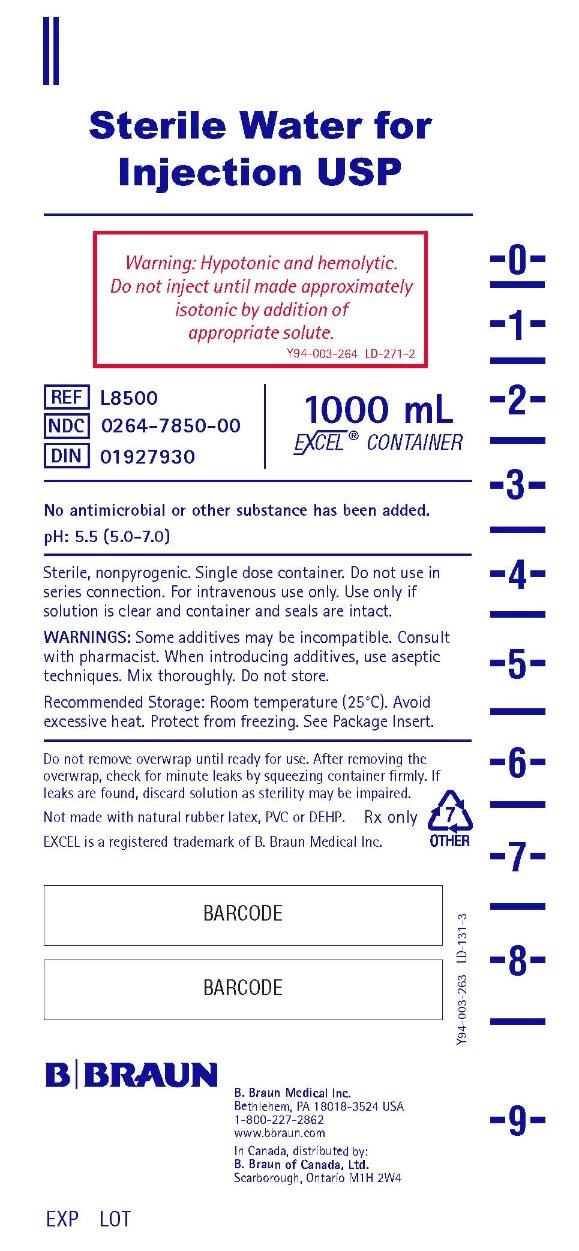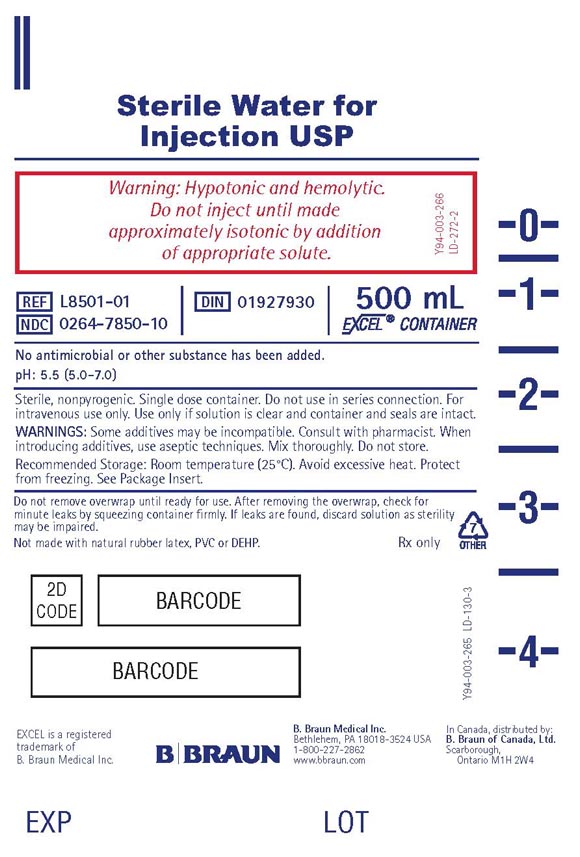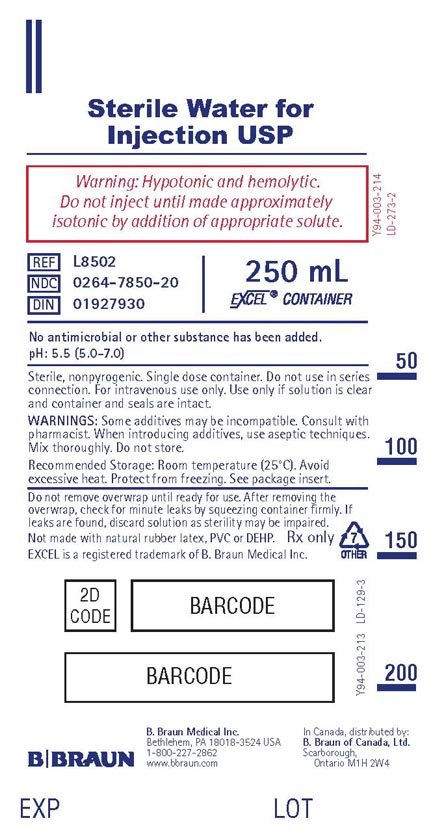Water for Injection: Package Insert / Prescribing Info
Package insert / product label
Dosage form: injection, solution
Medically reviewed by Drugs.com. Last updated on Apr 23, 2024.
On This Page
Warning: Hypotonic and hemolytic.
Do not inject until made approximately isotonic by addition of appropriate solute.
Water for Injection Description
Sterile Water for Injection USP is a clear, colorless, odorless liquid. It is sterile, hypotonic, nonpyrogenic, and contains no bacteriostatic or antimicrobial agents. Sterile Water for Injection USP is a diluent or solvent suitable for intravascular injection after first having been made approximately isotonic by the addition of suitable solute.
pH: 5.5 (5.0–7.0)
Not made with natural rubber latex, PVC or DEHP.
The plastic container is made from a multilayered film specifically developed for parenteral drugs. It contains no plasticizers and exhibits virtually no leachables. The solution contact layer is a rubberized copolymer of ethylene and propylene. The container is nontoxic and biologically inert. The container-solution unit is a closed system and is not dependent upon entry of external air during administration. The container is overwrapped to provide protection from the physical environment and to provide an additional moisture barrier when necessary.
Addition of medication should be accomplished using complete aseptic technique.
The closure system has two ports; the one for the administration set has a tamper evident plastic protector and the other is a medication addition site. Refer to the Directions for Use of the container.
Water for Injection - Clinical Pharmacology
Sterile Water for Injection USP is used as a diluent or solvent for other parenteral drugs. As such, Sterile Water for Injection USP contributes to the water for hydration when provided in parenteral drug and fluid therapy, after the introduction of suitable additives and/or mixture with suitable solutes to approximate isotonicity.
Indications and Usage for Water for Injection
Sterile Water for Injection USP is indicated for use in adults and pediatric patients as a diluent or solvent in the aseptic preparation of parenteral solutions or as a vehicle for drug administration.
Warnings
Hypotonic and hemolytic. Do not inject until made approximately isotonic by addition of an appropriate solute, due to the possibility of hemolysis.
The administration of intravenous solutions can cause fluid and/or solute overload resulting in dilution of serum electrolyte concentrations, overhydration, congested states or pulmonary edema. The risk of dilutional states is inversely proportional to the electrolyte concentration.
WARNING: This product contains aluminum that may be toxic. Aluminum may reach toxic levels with prolonged parenteral administration if kidney function is impaired. Premature neonates are particularly at risk because their kidneys are immature, and they require large amounts of calcium and phosphate solutions, which contain aluminum.
Research indicates that patients with impaired kidney function, including premature neonates, who receive parenteral levels of aluminum at greater than 4 to 5 mcg/kg/day accumulate aluminum at levels associated with central nervous system and bone toxicity. Tissue loading may occur at even lower rates of administration.
Precautions
General
To minimize the risk of possible incompatibilities arising from the mixing of additives that may be prescribed, the final infusate should be inspected for cloudiness or precipitation immediately after mixing, prior to administration and periodically during administration.
Do not use plastic containers in series connection.
If administration is controlled by a pumping device, care must be taken to discontinue pumping action before the container runs dry or air embolism may result. If administration is not controlled by a pumping device, refrain from applying excessive pressure (>300mmHg) causing distortion to the container such as wringing or twisting. Such handling could result in breakage of the container.
This solution is intended for intravenous administration using sterile equipment. It is recommended that intravenous administration apparatus be replaced at least once every 24 hours.
Use only if solution is clear and container and seals are intact.
The drug product contains no more than 25 mcg/L of aluminum.
Carcinogenesis, Mutagenesis, Impairment of Fertility
Refer to the package insert of the solute used.
Pediatric Use
Refer to the package insert of the solute used. See WARNINGS section regarding aluminum.
Geriatric Use
Refer to the package insert of the solute used. See WARNINGS section regarding aluminum.
Adverse Reactions/Side Effects
Refer to the package insert of the solute used.
Reactions which may occur because of the solution or the technique of administration include febrile response, infection at the site of injection, venous thrombosis or phlebitis extending from the site of injection, extravasation and hypervolemia.
The physician should also be alert to the possibility of adverse reactions to drug additives. Prescribing information for drug additives to be administered in this manner should be consulted.
If an adverse reaction does occur, discontinue the infusion, evaluate the patient, institute appropriate therapeutic countermeasures and save the remainder of the fluid for examination if deemed necessary.
Overdosage
Overdosage (hypotonic expansion) is a function of an increase in fluid intake over fluid output, and occurs when the increase in the volume of body fluids is due to water alone. Overdosage may occur in patients who receive large quantities of electrolyte-free water to replace abnormal excessive fluid losses, in patients whose renal tolerance to water loads is exceeded, or in patients who retain water postoperatively in response to stress.
Manifestations of water intoxication are behavioral changes (confusion, apathy, disorientation and attendant hyponatremia), central nervous system disturbances (weakness, muscle twitching, headaches, nausea, vomiting, convulsions) and weight gain.
Treatment consists of withholding fluids until excessive water is excreted. In severe hyponatremia it may be necessary to cautiously administer hypertonic saline to increase extracellular osmotic pressure and excretion of excess water by the kidneys.
Water for Injection Dosage and Administration
This solution is for intravenous use only. Do not inject until made approximately isotonic by addition of appropriate solute.
The dosage and administration of Sterile Water for Injection USP is dependent upon the recommended dosage and administration of the solute used. Fluid administration should be based on calculated maintenance or replacement fluid requirements for each patient.
Some additives may be incompatible. Consult with pharmacist. When introducing additives, use aseptic techniques. Mix thoroughly. Do not store.
Parenteral drug products should be inspected visually for particulate matter and discoloration prior to administration, whenever solution and container permit.
How is Water for Injection supplied
Sterile Water for Injection USP is supplied sterile and nonpyrogenic in EXCEL® Containers. The 1000 mL containers are packaged 12 per case; the 500 mL and 250 mL containers are packaged 24 per case.
| NDC | REF | Size |
|---|---|---|
| Sterile Water for Injection USP (Canada DIN 01927930) |
||
| 0264-7850-00 | L8500 | 1000 mL |
| 0264-7850-10 | L8501-01 | 500 mL |
| 0264-7850-20 | L8502 | 250 mL |
Exposure of pharmaceutical products to heat should be minimized. Avoid excessive heat. Protect from freezing. It is recommended that the product be stored at room temperature (25°C); however, brief exposure up to 40°C does not adversely affect the product.
Storage in automated dispensing machines: Brief exposure up to 2 weeks to ultraviolet or fluorescent light does not adversely affect the product labeling legibility; prolonged exposure can cause fading of the red label. Rotate stock frequently.
Directions for Use of EXCEL® Container
Warning: Hypotonic and hemolytic.
Do not inject until made approximately isotonic by addition of appropriate solute.
Caution: Do not use plastic containers in series connection.
To Open
Tear overwrap down at notch and remove solution container. Check for minute leaks by squeezing solution container firmly. If leaks are found, discard solution as sterility may be impaired. If supplemental medication is desired, follow directions below before preparing for administration.
NOTE: Before use, perform the following checks:
Inspect each container. Read the label. Ensure solution is the one ordered and is within the expiration date.
Invert container and carefully inspect the solution in good light for cloudiness, haze, or particulate matter. Any container which is suspect should not be used.
Use only if solution is clear and container and seals are intact.
Preparation for Administration
- Remove plastic protector from sterile set port at bottom of container.
- Attach administration set. Refer to complete directions accompanying set.
To Add Medication
Warning: Some additives may be incompatible.
To Add Medication Before Solution Administration
- Prepare medication site.
- Using syringe with 18–22 gauge needle, puncture medication port and inner diaphragm and inject.
- Squeeze and tap ports while ports are upright and mix solution and medication thoroughly.
To Add Medication During Solution Administration
- Close clamp on the set.
- Prepare medication site.
- Using syringe with 18–22 gauge needle of appropriate length (at least 5/8 inch), puncture resealable medication port and inner diaphragm and inject.
- Remove container from IV pole and/or turn to an upright position.
- Evacuate both ports by tapping and squeezing them while container is in the upright position.
- Mix solution and medication thoroughly.
- Return container to in use position and continue administration.
B. Braun Medical Inc.
Bethlehem, PA 18018-3524 USA
1-800-227-2862
www.bbraun.com
In Canada, distributed by:
B. Braun of Canada, Ltd.
Scarborough, Ontario M1H 2W4
Y36-002-999
LD-241-3
PRINCIPAL DISPLAY PANEL - 1000 mL Container Label
Sterile Water for
Injection USP
Warning: Hypotonic and hemolytic.
Do not inject until made approximately
isotonic by addition of
appropriate solute.
Y94-003-264 LD-271-2
REF L8500
NDC 0264-7850-00
DIN 01927930
1000 mL
EXCEL® CONTAINER
No antimicrobial or other substance has been added.
pH: 5.5 (5.0-7.0)
Sterile, nonpyrogenic. Single dose container. Do not use in
series connection. For intravenous use only. Use only if
solution is clear and container and seals are intact.
WARNINGS: Some additives may be incompatible. Consult
with pharmacist. When introducing additives, use aseptic
techniques. Mix thoroughly. Do not store.
Recommended Storage: Room temperature (25°C). Avoid
excessive heat. Protect from freezing. See Package Insert.
Do not remove overwrap until ready for use. After removing the
overwrap, check for minute leaks by squeezing container firmly. If
leaks are found, discard solution as sterility may be impaired.
Not made with natural rubber latex, PVC or DEHP.
Rx only

EXCEL is a registered trademark of B. Braun Medical Inc.
B. Braun Medical Inc.
Bethlehem, PA 18018-3524 USA
1-800-227-2862
www.bbraun.com
In Canada, distributed by:
B. Braun of Canada, Ltd.
Scarborough, Ontario M1H 2W4
Y94-003-263 LD-131-3
EXP
LOT

PRINCIPAL DISPLAY PANEL - 500 mL
Sterile Water for
Injection USP
Warning: Hypotonic and hemolytic.
Do not inject until made
approximately isotonic by addition
of appropriate solute.
Y94-003-342
LD-272-3
REF L8501-01
NDC 0264-7850-10
DIN 01927930
500 mL
EXCEL® CONTAINER
No antimicrobial or other substance has been added.
pH: 5.5 (5.0-7.0)
Sterile, nonpyrogenic. Single dose container. Do not use in series connection. For
intravenous use only. Use only if solution is clear and container and seals are intact.
WARNINGS: Some additives may be incompatible. Consult with pharmacist. When
introducing additives, use aseptic techniques. Mix thoroughly. Do not store.
Recommended Storage: Room temperature (25°C). Avoid excessive heat. Protect
from freezing. See Package Insert.
Do not remove overwrap until ready for use. After removing the overwrap, check for
minute leaks by squeezing container firmly. If leaks are found, discard solution as sterility
may be impaired.
Not made with natural rubber latex, PVC or DEHP.
Rx only

EXCEL is a registered trademark of B. Braun Medical Inc.
B. Braun Medical Inc.
Bethlehem, PA 18018-3524 USA
1-800-227-2862
www.bbraun.com
In Canada, distributed by:
B. Braun of Canada, Ltd.
Scarborough, Ontario M1H 2W4
Y94-003-265
LD-130-3
EXP
LOT

L8501-01
PRINCIPAL DISPLAY PANEL - 250 mL
Sterile Water for
Injection USP
Warning: Hypotonic and hemolytic.
Do not inject until made approximately
isotonic by addition of appropriate solute.
Y94-003-214
LD-273-2
REF L8502
NDC 0264-7850-20
DIN 01927930
250 mL
EXCEL® CONTAINER
No antimicrobial or other substance has been added.
pH: 5.5 (5.0-7.0)
Sterile, nonpyrogenic. Single dose container. Do not use in series
connection. For intravenous use only. Use only if solution is clear
and container and seals are intact.
WARNINGS: Some additives may be incompatible. Consult with
pharmacist. When introducing additives, use aseptic techniques.
Mix thoroughly. Do not store.
Recommended Storage: Room temperature (25°C). Avoid
excessive heat. Protect from freezing. See Package Insert.
Do not remove overwrap until ready for use. After removing the
overwrap, check for minute leaks by squeezing container firmly. If
leaks are found, discard solution as sterility may be impaired.
Not made with natural rubber latex, PVC or DEHP.
Rx only

EXCEL is a registered trademark of B. Braun Medical Inc.
B. Braun Medical Inc.
Bethlehem, PA 18018-3524 USA
1-800-227-2862
www.bbraun.com
In Canada, distributed by:
B. Braun of Canada, Ltd.
Scarborough, Ontario M1H 2W4
Y94-003-213
LD-129-3
EXP
LOT

L8502
| STERILE WATER
water injection |
||||||||||||||||||||||||||||||||||||||||
|
||||||||||||||||||||||||||||||||||||||||
|
||||||||||||||||||||||||||||||||||||||||
|
||||||||||||||||||||||||||||||||||||||||
|
||||||||||||||||||||||||||||||||||||||||
| Labeler - B. Braun Medical Inc. (002397347) |
Water for injection Biosimilars
Biosimilar and interchangeable products are biological products that are highly similar to and have no clinically meaningful differences from the reference product.
Reference products
These are biological products that have already been approved by the FDA, against which biosimilar products are compared. There are 3 for Water for Injection.
Jynneos (Smallpox and Mpox Vaccine, Live, Non-replicating) - Bavarian Nordic A/S
| Formulation type | Strength |
|---|---|
| Single-Dose Vial | 0.5-3.95 X 10 E8 INF. U/.5 mL |
| Single-Dose Vial | 0.5-3.95 X 10 E8 INF. U/.5 mL |
View Jynneos information in detail.
M-M-R Ii (Measles, Mumps and Rubella Virus Vaccine Live) - Merck Sharp & Dohme LLC
| Formulation type | Strength |
|---|---|
| Single-Dose Vial | 0.5 mL |
| Single-Dose Vial | 0.5 mL |
View M-M-R Ii information in detail.
Zostavax (Zoster Vaccine Live) - Merck Sharp & Dohme LLC
| Formulation type | Strength |
|---|---|
| Single-Dose Vial | 0.65 mL Discontinued |
View Zostavax information in detail.
